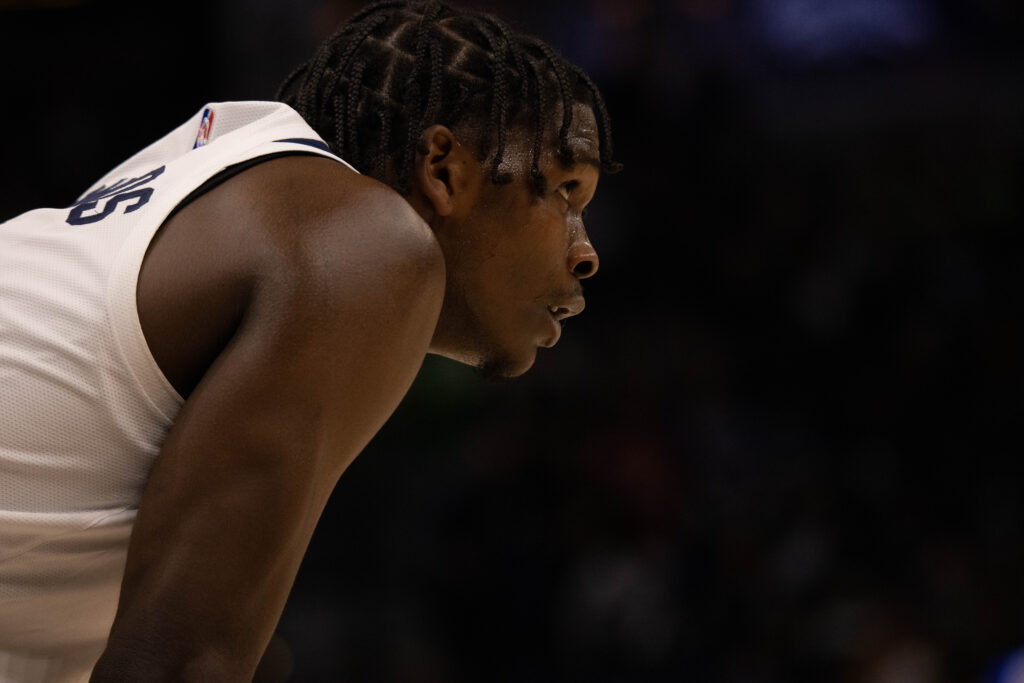Anthony Edwards scanned a room of mostly empty chairs and said, “so this is how we do media now.” It was opening night of Edwards’ second season in the league, and time for the 20-year-old to do the first in-person postgame press conference of his career. A very-2021 development for a young man whose identity as a professional athlete to that point felt defined by what he has said in front of a microphone as much as it has been defined by what he has been able to do on the basketball court.
That pandemic-ridden rookie season, filled with 23 wins and 49 losses, still brought joy to a fanbase through Edwards’ genuine and comical postgame pressers that exclusively took place over Zoom. Almost nightly, a clip of Edwards would go viral — about his dancing earrings, or about how he didn’t know who Alex Rodriguez was, and, of course, the time he unsuccessfully attempts to hide a bag of Popeyes Chicken.
Again on opening night, after the Wolves started the season off on the right foot with a win over Houston, Edwards disarmed a room of writers — this time in-person — with eye contact and a smile that said: You know, it’s alright for you guys to enjoy this, we won. He was tempting a group of journalists to have some fun with him. And we gave in.
By the end of his six-minute presser, Edwards had the room firmly in the palm of his hand, with the gathered media rolling as he described how he told Houston’s coach Stephen Silas during the game to “call a damn timeout” because “he was hot”.
Anthony Edwards read the room, and then he took it over.
Anthony Edwards told the Rockets they needed a timeout 😂
"I was telling the coach to call a damn timeout. You need a timeout. I'm hot!"pic.twitter.com/MJRmt05XYc
— Ballislife.com (@Ballislife) October 21, 2021
Winning over a fanbase and the media with charisma is one challenge in the process of becoming a star in this lead. But that feat pales in comparison to his next social challenge. Edwards is now being tasked with reading his locker room — navigating a path to leadership on a roster that already has two former All-Stars five years his senior. Karl-Anthony Towns and D’Angelo Russell both entered this year openly asserting they feel they have something to prove. Not to mention the lucrative contract extensions the incumbent leaders of the locker room are eligible for at the season’s end.
So how does one lead already established leaders?
“The most effective way for him to lead is to be really good at the things he’s supposed to be good at,” says head coach Chris Finch. “And then holding his teammates accountable in their effort. I’m a firm believer that you either are a leader or you’re not. And if you have it in you, it’ll come out in whatever way it needs to.”
Edwards’ chosen tactic has been accountability. Two games after his opening night press conference, Edwards came to the postgame podium with a clear message: Share the damn ball.
“We think we the only ones on the team,” Edwards said after the Wolves’ first loss of the season to a Zion Williamson-less New Orleans Pelicans team at home. “We got to be willing to pass the ball. There’s no I in team. We can’t beat five people with three people. We beat five people with five people.”
We… We… We…
Those lines initially came off as contentious in their clear direction towards Towns and Russell. But when asked if the lack of ball movement was a matter of team chemistry, Edwards was to the point.
“Nope. Got nothing to do with the chemistry,” Edwards said sternly, understanding the question’s implication. “We got chemistry. Just got to trust our teammates and that’s it. Be willing to pass the ball.”
Edwards’ statements seemed to light a fire beneath his team. The Wolves practiced the morning after Edwards delivered his message. And after that practice, Finch described the morning session as “a little testy”.
“They were bothered because we care,” Finch explained. “So I thought it was a really good practice. Exactly what we needed.”
The next night the Wolves went to Milwaukee and defeated the defending champions. Towns, Edwards and Russell had their best game as a trio since the three joined forces, scoring a combined 79 points (29 for Russell, 25 for Towns and 25 for Edwards). Even though the Big 3 dominated the scoring, it was the Wolves’ best ball-movement game of the season. Thirteen shots were made by players outside of Towns, Edwards and Russell, and the Big 3 assisted on six of those 13 makes.
It doesn’t feel as if Edwards’ motivation for speaking up about sharing the ball is about getting a ton of shots for The Others. Instead, his tactic seems motivated by engaging them. Quite frankly, it would be misguided to significantly limit the looks of any of The Big 3 in favor of getting, say, Jaden McDaniels or Josh Okogie more shots. That’s not their game. But there is a difference between shots and touches. Edwards believes touches generated through ball movement inspire energy and engagement. And that seems to be what Edwards is about, on and off the court — positive energy.
After the win in Milwaukee, Edwards said, “as far as everybody touching the ball, everybody being happy and feeling good, I was pretty satisfied with tonight.”
Edwards, Towns have different leadership styles
It’s not so surprising that Edwards has asserted himself as a leader in his second season. The eye test says a star is brewing here, and stars lead. The surprising part is the way he’s gone about it. Or that he’s gone about it at all. Never once in his rookie season did Edwards come anywhere near calling out a teammate or coach publicly. Frankly, his speaking to the media last season felt more like stand-up comedy than anything of real substance. So to come out firing with public calls for accountability was surprising in its ethos.
It was also jarring how different this chosen leadership tactic was in juxtaposition to Towns’ style. For years, Towns has taken all of the blame. Any needed accountability he always puts on himself.
I… I… I…
For example, that same night Edwards delivered his message, Towns sat at the same podium 15 minutes prior and said, “it falls on me,” when asked about the team’s lack of consistency that led to the loss.
“When it comes down and you’re a leader,” Towns continued, “when there’s blame on the team you have to be willing to have strong enough shoulders to take all the blame and when given the glory, give it to everybody else. I’m willing to pay that price every single day.”
(As someone who has attended at least 100 Towns media availabilities over the years, I’m not sure there is a single quote that better summarizes what Towns believes his leadership style is.)
One style isn’t necessarily right or wrong. You’re certainly not going to ruffle any feathers in the locker room using that tactic if you’re Towns. And Edwards’ style will almost certainly lead to blowback someday. But a lack of confrontation may also lead to a lack of needed change. Rather than one style being better or worse, it’s mostly just interesting that these are the first breadcrumbs that illustrate Edwards and Towns are going to have very different styles as leaders.
Around the team, the topic of leadership came up frequently during media availabilities in the days following Edwards’ message.
Josh Okogie, who is the longest-tenured player on the roster other than Towns, has earned the role of emotional leader through his personality and the fire he plays with. When asked about Edwards’ growing leadership role and his style as a leader, Okogie said, “That’s who Ant is.”
“He says what’s on his mind,” Okogie explained. “You guys have seen all the funny stuff that he says. That’s the kind of guy he is. Whether it’s funny, real, whatever it is, whatever is on his mind, he’ll get it out.”
Thirty-three-year-old Patrick Beverley is the only player on the team who is in his 30s, and has clearly seized the leadership role of “vet.” And when he was asked if Edwards’ age played a role in leadership, Beverley said, “no such thing.”
“Being able to go through experiences and tough times builds character,” Beverley continued. “Of course you go through that with age. But I’ve done met some of my finest leaders in some of the youngest guys I’ve met. So it really doesn’t matter.”
Edwards is making a case that he has it in him. And that’s a new development this season.
Edwards and Towns may be on a collision course
With Edwards’ star ascending as a basketball player toward the levels Towns has already achieved, the Wolves are on the cusp of a collision. Not necessarily a bad one, but a collision nonetheless. Towns and Edwards will either synergize as co-leaders or this will become a “whose team is it?” situation.
While that may feel like it puts a lot of pressure on Towns, really, it’s on Edwards to navigate. Towns was already established as the clear-cut best player and leader of the team when Edwards arrived in Minnesota. That’s often how pecking order works in the NBA. And that’s why it’s on Edwards to read the room and find a tactic to lead while effectively co-existing with Towns — for as long as they are both on the same roster.
Jamal Murray has effectively navigated a very similar path to co-leadership next to Nikola Jokic in Denver. And Michael Porter Jr. has slid in as third in command. The Nuggets got a little lucky that Jokic (clearly the best of the three) got to Denver first, and that Murray (second-best) and Porter Jr. (third-best) arrived in descending order — Jokic 2015, Murray 2016, Porter Jr. 2018.
(Worth noting: Chris Finch was the associate head coach of the Nuggets during Murray’s rookie season in Denver.)
A difference in Minnesota, however, is the order in which the three best players entered the fold. If the Wolves ever become a true contender with this core, it will almost certainly be because Edwards has become the best player on the roster. But Edwards arrived after not only Towns but also Russell. The aspirational pecking order and timelines in which those in the order arrived are incongruent.
It’s not only the winning in Denver but the synergy of the group that has made it all but a foregone conclusion that Jokic will sign an extension for over $200 million this coming offseason. A similar deal to the 4-year, $196 million extension Joel Embiid signed in Philadelphia this past offseason. With Towns, even though he has repeatedly spoken of a desire to play his entire career where he was drafted, there is less certainty that he will sign his $200 million extension in Minnesota.
And yes, Towns is eligible for that extension this offseason. Including this current season, Towns does have three years remaining on his current maximum contract. But his standing, having played for the same team his entire career, by league rule, allows him to sign his extension this coming summer. The same exact four-year contract extension Embiid tacked on to the final two years of his current contract.
What does the future hold for Towns and the Timberwolves?
Decision time on what the future of the Timberwolves pecking order will be is coming sooner than it may have seemed. So questions loom, and with those a corresponding decision tree:
- Will Towns commit to the Timberwolves through 2028 if offered a four-year extension?
- Does Minnesota want to make that long-term commitment?
While $200 million over four years sounds like a ton, players of Towns’ caliber around the league are still typically viewed as positive assets at that rate — barring some sort of injury that derails the quality of his play.
Yes, the John Wall contract extension signed in 2017 was a complete disaster. But the demand for 31-year-old Damian Lillard, who signed the same extension in 2019, still feels pretty high. Towns will still only be 31 years old in 2028.
Of course, Towns could refuse to sign the extension, wanting to delay his decision or altogether push his way out of town. Minnesota could also be the ones who initiate the push-out — looking for a haul of young players and/or draft picks that buy time, better fitting the Edwards-led pecking order and timeline. And it’s not hard to make a list of teams who fancy themselves fringe contenders that might believe Towns would elevate them to a championship level.
One hypothetical: Might the now ascending Chicago Bulls be interested in reuniting Towns with Zach LaVine? Perhaps slotting Towns into the stretch forward role he has never played in Minnesota, next to a true center in Nikola Vucevic. Would Minnesota be interested in a package of, say, Patrick Williams, Lonzo Ball and whatever the requisite number of first round picks would be? The 24-year-old Ball is signed through 2025 and Williams, through restricted free agency, is under team control through at least 2028.
The roots of the decision tree for Minnesota spread widely all based on the question of whether or not Towns is going to be a long-term fixture in Minnesota. And that question will likely be answered by this impending collision between Towns and Edwards at the top of the Wolves’ pecking order.
This is how the chessboard has been set by a historically incompetent franchise that, quite frankly, hasn’t exactly set Towns up for success. Could you blame him for wanting out? That same incompetence that led to historic amounts of losing also brought Edwards to Minnesota. He’s here now, committed and under team control through 2029.
Because of this, Edwards’ next move, as a player and a leader, will likely write the next critical chapter in this Timberwolves story. And that’s why Anthony Edwards has to read the room.
Dane Moore is lauded as a Timberwolves insider and we’re excited that he’ll be writing Timberwolves columns for Bring Me The News. You can follow him on Twitter and catch his daily podcast here. Moore’s debut column dives into the leadership collision course Anthony Edwards and Karl-Anthony Towns are on.








